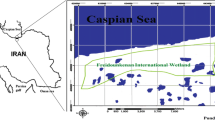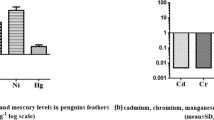Abstract
Concentrations of five metals and selenium in the breast feathers of known-aged common terns (Sterna hirundo) were examined at a breeding colony in Massachusetts, USA. Concentrations of selenium, chromium, and manganese increased significantly with age among adults (2–21 years old), whereas concentrations of mercury, cadmium, and lead did not. Concentrations of cadmium, selenium and manganese were lower in fledglings (20–23 days old) than in adults. Concentrations of mercury, however, were higher in fledglings than in adults, and concentrations of chromium were higher in fledglings than in young adults, probably reflecting higher exposure to these metals in the breeding area than in the winter quarters where the adults' feathers were grown. At least for mercury, excretion of metals into the feathers at each molt was an efficient protective mechanism, preventing continued accumulation in the body with increasing age.
Similar content being viewed by others
References
Austin OL (1953) The migration of the common tern (Sterna hirundo) in the Western Hemisphere. Bird-Banding 24:39–55
Braune BM (1987) Comparison of total mercury levels in relation to diet and molt for nine species of marine birds. Arch Environ Contam Toxicol 16:217–234
—, Gaskin DE (1987a) Mercury levels in Bonaparte's gull (Larus philadelphia) during autumn molt in the Quoddy region, New Brunswick, Canada. Arch Environ Contam Toxicol 16:539–549
—, — (1987b) A mercury budget for the Bonaparte's gull during autumn moult. Ornis Scand 18:244–250
Burger J, (1992) Metals in feathers of brown noddy (Anous stolidus): Evidence for bioaccumulation or exposure levels? Environ Monit Asses 24:181–187
—, Cooper K, Saliva J, Gochfeld, D, Lipsky D, Gochfeld M (1992a) Mercury bioaccumulation in organisms from three Puerto Rican estuaries. Environ Monit Asses 22:181–197
—, Nisbet ICT, Gochfeld M (1992b) Metal levels in regrown feathers: assessment of contamination on the wintering and breeding grounds in the same individuals. J Toxicol Environ Health 37:363–374
—, Parsons K, Benson T, Shukla T, Rothstein D, Gochfeld M (1992c) Heavy metal and selenium levels in young cattle egrets from nesting colonies in the Northeastern United States, Puerto Rico, and Egypt. Arch Environ Contam Toxicol 23:435–439
--, Pokras M, Chafel R, Gochfeld M. Heavy metal concentrations in feathers of common loon (Gavia immer) in the Northeastern United States and age difference in mercury levels. Environ Monit Asses (in press).
—, Gochfeld M (1990) Tissue levels of lead in experimentally exposed Herring Gull (Larus argentatus) chicks. J Toxicol Environ Health 29:219–233
—, — (1993) Heavy metal and selenium levels in feathers of young egrets from Hong Kong and Szechuan, China. Arch Environ Contam Toxicol 25:322–327
Cramp S (Ed) (1985) The birds of the Western Palearctic. Vol IV. Oxford University Press, Oxford, UK, 913 pp
Custer TW, Franson JC, Myers JC, Moore JF (1986) Reproductive success and heavy metal contamination in Rhode Island common terns. Environ Pollut Ser A 41:33–52
Eisler R (1985) Selenium hazards to fish, wildlife and invertebrates: A synoptic review. US Fish Wildl Serv Biol Rep 85(1.5), 57 pp
Furness RW, Muirhead SJ, Woodburn M (1986) Using bird feathers to measure mercury in the environment: Relationships between mercury content and moult. Mar Pollut Bull 17:27–37
—, Rainbow PS (1990) Heavy metals in the marine environment. CRC Press, Boca Raton, FL
—, Lewis SA, Mills JA (1990) Mercury levels in the plumage of red-billed gulls (Larus novaehollandiae scopulinus) of known sex and age. Environ Pollut 63:33–39
Gochfeld M, Burger J (1987) Factors affecting tissue distribution of heavy metals. Biol Trace Element Res 12:389–399
—, — (1989) Tissue distribution of lead in young common terns; influence of time since exposure. Environ Res 50:262–268
Goede AA, de Bruin M (1984) The use of bird feather parts as a monitor for metal pollution. Environ Pollut Ser B 8:281–298
Honda K, Min BY, Tatsukawa R (1986) Distribution of heavy metals and their age-related changes in the eastern great white egret (Egretta alba modesta) in Korea. Arch Environ Contam Toxicol 15:185–197
Honda K, Marcovecchio JE, Kan S, Tatsukawa R, Ogi H (1990) Metal concentrations in pelagic seabirds from the North Pacific Ocean. Arch Environ Contam Toxicol 19:704–711
Hunter BA, Johnson JG (1982) Food chain relationships of copper and cadmium in contaminated grassland ecosystems. Oikos 38:108–117
Langham NP (1971). Seasonal movements of British terns in the North Atlantic Ocean. Bird Study 18:155–175
Lewis SA, Furness RW (1991) Mercury accumulation and excretion by laboratory reared black-headed gull (Larus ridibundus) chicks. Arch Environ Contam Toxicol 21:316–320
Nelson JB (1979) Seabirds: Their biology and behavior. A & W Publishers, NY
Nisbet ICT, Drury WH (1972) Measuring breeding success in common and roseate terns. Bird-Banding 43:97–106
— (1973) Courtship-feeding, egg-size and breeding success in common terns. Nature 241:141–142
— (1983) Territorial feeding by common terns. Colonial Waterbirds 6:64–70
—, Winchell JM, Heise AE (1984) Influence of age on the breeding biology of common terns. Colonial Waterbirds 7:117–126.
— (1993) Effects of pollution on marine birds. In: Nettleship DN, Burger J, Gochfeld M (eds) Seabirds on islands: Threats, case studies and action plans. ICBP Technical Publication No. 8. International Council on Bird Preservation, Cambridge (in press)
Norheim G (1987) Levels and interactions of heavy metals in seabirds from Svalbard and the Antarctic. Environ Pollut 47:83–94
Peakall D (1992) Animal biomarkers as pollution indicators. Chapman and Hall, London
SAS (1985) SAS user's guide: Statistics. SAS Inst., Sparks Press, Raleigh, NC
Solonen T, Lodenius M (1990) Feathers of birds of prey as indicators of mercury contamination in southern Finland. Holarctic Ecol 13:229–237
Stoneburner DL, Harrison CS (1981) Heavy metal residues in sooty tern tissues from the Gulf of Mexico and North Central Pacific Ocean. Sci Total Environ 17:51–58
van Straalen NM, Ernst E (1991) Metal biomagnification may endanger species in critical pathways. Oikos 62:255–256
Author information
Authors and Affiliations
Rights and permissions
About this article
Cite this article
Burger, J., Nisbet, I.C.T. & Gochfeld, M. Heavy metal and selenium levels in feathers of known-aged common terns (Sterna hirundo) . Arch. Environ. Contam. Toxicol. 26, 351–355 (1994). https://doi.org/10.1007/BF00203562
Received:
Revised:
Issue Date:
DOI: https://doi.org/10.1007/BF00203562




